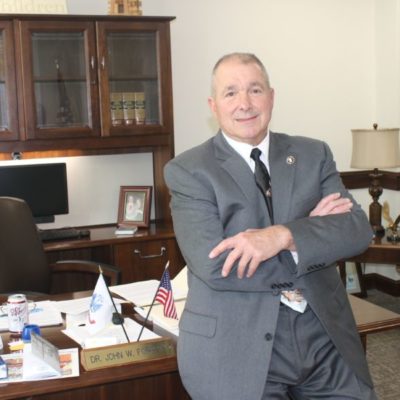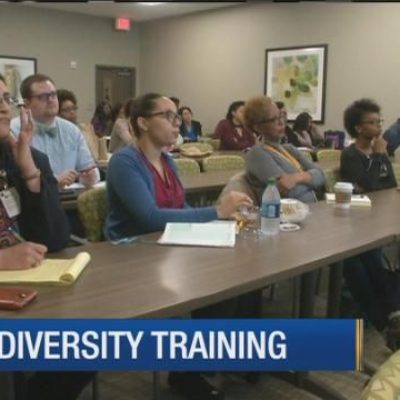After-School Programs Keep Learning Going With Student Data
Not long after the last school buses leave Isaac Litton Middle School at the end of the day, the first buses from a dozen other East Nashville schools start to arrive for the after-school enrichment program, Backfield in Motion. Teacher Candra Clariette helps a double handful of boys slowly work through Peggy Kern’s book “No Way Out.” It’s always a tricky task, she said, to find a book that meets the interests, reading level, and curricular needs of middle schoolers from seven different local district and charter schools.
“I know I’m responsible for my students and I’m not in the classroom with them, but I can help their teachers by integrating literacy here,” said Clariette, who is also a literacy specialist at Haynes Middle School in her day job. “It’s kind of a mirror.”
While many after-school teachers across the country work to tailor their programs to students or to align to local curriculum, Clariette has an edge: Backfield in Motion gets detailed data from Nashville public schools on her students’ academic scores, behavior, attendance, and interests—along with the training to use the information to tailor instruction.
Backfield in Motion is one of dozens of groups in the Nashville After Zone Alliance. Known as NAZA, the partnership between the city and the Nashville district launched in 2009 to exchange student data during and outside the school day. The Nashville Public Library, which runs the alliance, coordinates training and support for schools and providers.
“Learning does not stop at 3 p.m., and it does not stop in June when kids are out for summer,” said Abby Cohen, a senior associate for policy and advocacy at the Data Quality Campaign, a nonprofit group which advocates for better use of education data and which has studied NAZA.
In a nationwide survey this year, the group found that 86 percent of parents would like their child’s school to share relevant academic information with his or her extracurricular providers.
In exchange for school data on student discipline, attendance, special education needs, and math, reading, and science scores, each after-school group provides data on participating students’ attendance and progress and undergoes an independent evaluation each year.
“This is a whole new way of doing business in after-school programs, and it’s a constant work in progress,” Bela Spooner, the manager of expanded-learning initiatives at the National League of Cities Institute for Youth, Education, and Families. “There’s this push and pull: ‘We want after-school to align with school!’ ‘We want school to look more like after-school!’ ”
Community groups and other after-school providers, she said, “are trying to … expand young people’s horizons—but there’s a lot of pressure on after-school providers to improve students’ academic achievement.”
Training for Exchange
The National League of Cities estimates that only about a third of cities that have after-school programs use common data systems with their schools. Nashville was part of the league’s 17-year Next-Generation Afterschool System-Building Initiative, which followed more than two-dozen cities attempting to create networks for after-school providers.
Even within those next-generation cities, “Nashville is unique,” said Spooner. “They’ve been able to move their work along faster than in some places because the city has been able to work closely with the school system; there’s often a problem of student-data privacy and trust between big systems,” she said. “Other cities like Denver are doing strategic data-sharing with school districts, but … in most places, it’s still one-sided.” Nashville, she said, is the only one training community groups and school staff to work together.
Although some community groups collected their own data or reached out to schools before NAZA, very few had training in how to collect and analyze data systemically or meet federal and state laws on keeping student data secure. Rather than trying to work around myriad federal and state privacy laws, parents are asked as part of extracurricular enrollment to sign a consent form to allow the school to share attendance, academic, and behavior data with after-school providers.
While it’s voluntary, parents rarely opt out. “They understand if they don’t [approve data sharing], the programs will be just kind of a one-size-fits-all approach, and parents really do want the personalized experience for their students,” said Laura Hansen, Metro Nashville public schools’ director of information management and decision support.
To join the network, providers undergo 12 hours of free training each year on positive youth development, understanding the evaluation system, and digging into data, among other topics. Twice a year, providers join district teachers for “data dives” to look at the needs and progress of students in their programs.
“It’s an excellent tool for after-school programs—12 hours of training every year at no cost to me,” said Micah Kimble, the vice president of Backfield in Motion.
The Nashville-based Dan and Margaret Maddox Charitable Fund supported community after-school programs long before NAZA was launched, but Kaki Friskics-Warren, the fund’s executive director, said the initiative’s required evaluations have helped the fund target its grants.
“So often with data, it can be used to beat someone up—you’re not doing this well or why did this program get more points than you got in a certain area—but NAZA was really about the rising tide floats all boats,” she said. “This is data that would motivate people to improve and would help people see, ‘Oh, this is where we’re putting our energy in one place when we really need to be putting it somewhere else.’ ”
For example, Backfield in Motion has always provided low-income boys in east Nashville with free supper, mentors, and an hour each of academics and sports each day. But Kimble said as a result of its data dives and discussions with schools, the group expanded its sessions to include science and art classes and incorporated more time during academic sessions for students to reflect on what they were learning and what they wanted to study. “We get to see exactly what our kids are interested in, what they love about the program, and what they didn’t,” he said.
While providers are not on planning teams for students with individualized education plans, Kimble said they now receive students’ IEPs and have hired a district special education teacher to help provide supports for students.
Data in Motion
Sharing data also helps the district respond more quickly to changing needs, Hansen said. In one year, a school administrator alerted the after-school network that new Somali immigrant students were clustered in one large apartment building. The apartment manager agreed to open a ground-floor apartment that year to be used for a short-term English-language-learning after-school program to help boost the students’ proficiency with their new language.
“It had curriculum from the district, had after-school providers looking more at good pedagogy,” Hansen said. “The impact of just that activity was huge for these students.”
Last year at Wright Middle School, Jennifer DeWall, the NAZA site coordinator, worked with 6th grade teachers who noticed a cluster of students struggling in math. DeWall helped the teachers connect their students to a local after-school program that generally provided homework help but was also able to tailor tutoring for the math concepts the teachers had found lacking.
“There’s great value in this [data-sharing] program,” said Sharada Deaton, the executive principal of Wright Middle School. “This is a school where students come in with many needs—high poverty, 34 percent are English-learners, 14 percent are both English-learners and have special needs. We cannot address all those needs during the school day.”
In an early evaluation of NAZA, the American Institutes for Research found “consistent evidence” that higher after-school attendance, particularly of programs rated as high-quality, was associated with small boosts to students’ math and science grades in 2012-13 and fewer discipline problems during the school day.
“The value of data sharing isn’t just about gaining knowledge but about collaboration,” Hansen said. “Data is the magnet that brings people together under a shared understanding of what needs to be done.”
Coverage of after-school learning opportunities is supported in part by a grant from the Charles Stewart Mott Foundation. Education Week retains sole editorial control over the content of this coverage.
[Read more at Education Week]



